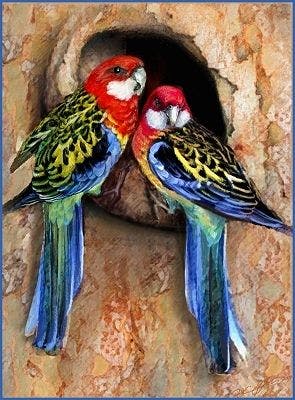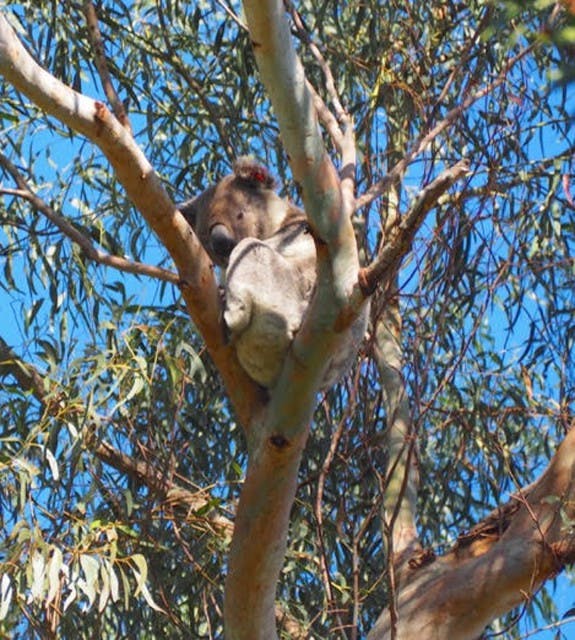Protecting our paddock trees
Consultation has concluded
 Paddock trees are big, old, majestic native trees that often stand alone like sentinels from another time. They graciously provide shelter for stock, nectar for honeybees, hollows for nesting, and places of rest and safety for weary wildlife.
Paddock trees are big, old, majestic native trees that often stand alone like sentinels from another time. They graciously provide shelter for stock, nectar for honeybees, hollows for nesting, and places of rest and safety for weary wildlife.
Studies have shown economic and environmental benefits from keeping paddock trees and small patches of native trees in a rural landscape.
This page honours the humble paddock tree and aims to assist these valuable giants outlining how they can be protected.
Share a story about your favourite paddock tree.
Council is offering assistance to landholders to keep their trees in good health and assist regeneration of future trees. Click here to find out more or phone Council on (02) 6670 2419.
Council has instigated the planting of more than 30,000 trees at 37 priority locations on the Tweed Coast during the past four years, in response to the dwindling koala population. The plantings have been mixed, with an emphasis on koala food trees.
 Paddock trees are big, old, majestic native trees that often stand alone like sentinels from another time. They graciously provide shelter for stock, nectar for honeybees, hollows for nesting, and places of rest and safety for weary wildlife.
Paddock trees are big, old, majestic native trees that often stand alone like sentinels from another time. They graciously provide shelter for stock, nectar for honeybees, hollows for nesting, and places of rest and safety for weary wildlife.
Studies have shown economic and environmental benefits from keeping paddock trees and small patches of native trees in a rural landscape.
This page honours the humble paddock tree and aims to assist these valuable giants outlining how they can be protected.
Share a story about your favourite paddock tree.
Council is offering assistance to landholders to keep their trees in good health and assist regeneration of future trees. Click here to find out more or phone Council on (02) 6670 2419.
Council has instigated the planting of more than 30,000 trees at 37 priority locations on the Tweed Coast during the past four years, in response to the dwindling koala population. The plantings have been mixed, with an emphasis on koala food trees.
-
Many benefits from paddock trees
Share Many benefits from paddock trees on Facebook Share Many benefits from paddock trees on Twitter Share Many benefits from paddock trees on Linkedin Email Many benefits from paddock trees link
Paddock trees bring many benefits for landholders, wildlife and the wider community.
They can reduce stress on stock by providing shelter from wind, heat and cold. Stress from heat and cold can limit weight gains in cattle and reduce milk production.
Birds, sugar gliders, lizards and bats that live in paddock trees feed on large numbers of pest insects.
Many animals such as birds and koalas use large, old trees for resting, feeding, protection from predators and stepping stones to larger patches of bush. Tree hollows, including dead trees, are used for resting and nesting by gliders and birds such as owls and glossy black cockatoos.
Large branches provide resting places for koalas, while fallen branches provide habitat for small ground dwelling animals such as reptiles.
Some of the big old native trees on the Tweed Coast include tallowwood, forest red gum, blackbutt, swamp mahogany, figs and sheoaks. Some of these trees are hundreds of years old and cannot be replaced in a person’s lifetime.
Native vegetation and individual native plants have resilience — the ability to regenerate after disturbance. This has evolved over thousands, even millions, of years as a response to disturbances such as landslip, flood, grazing, drought and fire.
Click here to find out more.
-
Share the love of your favourite paddock tree
Share Share the love of your favourite paddock tree on Facebook Share Share the love of your favourite paddock tree on Twitter Share Share the love of your favourite paddock tree on Linkedin Email Share the love of your favourite paddock tree link
“It's on the roadside and not in a paddock but I love this tree as it is one of the biggest and oldest forest red gums around” ...Share your story about your favourite paddock tree. Visit the storyboard to share your photos and anecdotes.
Where is your favourite tree and what do you love about it?
-
Why paddock trees are dying
Share Why paddock trees are dying on Facebook Share Why paddock trees are dying on Twitter Share Why paddock trees are dying on Linkedin Email Why paddock trees are dying link
Isolated trees are in decline and dying in some regions.
Often this is because they are old and reaching the end of their natural life. In other cases, healthy tress are used for firewood and fenceposts.
In many instances, these trees are not being replaced and they are eventually lost, one by one, from the landscape.
In some cases they are dying prematurely: as a result of changes in land use around them such as herbicide spray drift, changes in the water table, soil compaction from stock, increased nutrient levels from fertilisers and insect attack after habitat for natural predators has been removed.
-
How to look after big, old trees
Share How to look after big, old trees on Facebook Share How to look after big, old trees on Twitter Share How to look after big, old trees on Linkedin Email How to look after big, old trees link
The top priority in protecting paddock trees is creating conditions suitable for tree regeneration.
Temporary fencing is one of the best solutions for managing isolated trees, to 'give them a break’ and to encourage growth and regeneration. The fenced off area should be twice the size of the canopy of the tree or trees.
After two or three years, young seedlings might have grown above browse height, so the fencing can be moved to another tree or clump of trees.
Allow the trees to regenerate from fallen seeds. Connect these fenced clumps together and link them to larger areas of native vegetation, such as roadsides, stock routes and reserves.
In some situations, this might not be practical. It might cost too much, take too long or take too much land out of production. If so, consider the following:
- avoid the use of fertilisers under the canopy and around the trees
- avoid cultivating under the canopy of the trees
- ensure herbicide doesn’t drift onto the trees
- don’t scorch the trees if burning off
- leave fallen branches and sticks where they fall under the trees
Fencing is still important. Fence off larger clumps of trees where possible. If planning new fence lines, position them to provide protection for clumps of older trees.
Also consider:
- allowing tree debris to remain on ground
- controlling weeds before the tree seeds fall to the ground
- re-establishing missing native shrubs and grasses using local seed
- excluding non-native animals (especially rabbits and hares)
- using fire in the regenerating patches for ecological purposes only
-
Natural branch shedding is the best
Share Natural branch shedding is the best on Facebook Share Natural branch shedding is the best on Twitter Share Natural branch shedding is the best on Linkedin Email Natural branch shedding is the best linkThe formation of hollows in trees is typically initiated by wind damage, natural branch shedding, termites and other boring insects such as longicorn beetles.
Lightning, fire damage and internal fungal and bacterial decay are also common causes of hollows in trees.
In Australia, the formation of hollows tends to be an especially slow process because there are no vertebrate animals that actively engineer hollows, such as woodpeckers.
There are four main types of hollows: rounded hollows in the main stem, rounded hollows where branches have broken off, fire scars at the base of trees, and fissures or cracks in branches or the main stem, with vertical entrances.
Both living and dead trees provide natural hollows.
-
Home, lungs and shade in one gentle giant
Share Home, lungs and shade in one gentle giant on Facebook Share Home, lungs and shade in one gentle giant on Twitter Share Home, lungs and shade in one gentle giant on Linkedin Email Home, lungs and shade in one gentle giant link
Trees are vital in improving the visual quality of an area.
Tree cover forms an integral part of Tweed Shire's character, in its bushland and urban areas.
Trees play an important part in:- providing habitat and food for wildlife, maintaining the health of our lands and our living environment
- protecting soil and water supplies
- providing shelter and protection from predators for many birds, animals and insect species
- acting as extensions and links between core bushland, as bushland corridors (particularly in urban areas)
- reduce the effects of sunlight, summer heat, reflection, pollution, humidity, wind, glare, refraction and noise
- filtering the air and significantly reducing airborne pollution by acting as the 'lungs of the earth', taking in and storing carbon dioxide and producing oxygen
With these principles in mind, Council’s Development Control Plan A16 Preservation of Trees and Vegetation and old Tree Preservation Orders (TPOs) seek to retain trees that contribute to the general health and well being of Tweed Shire residents.


